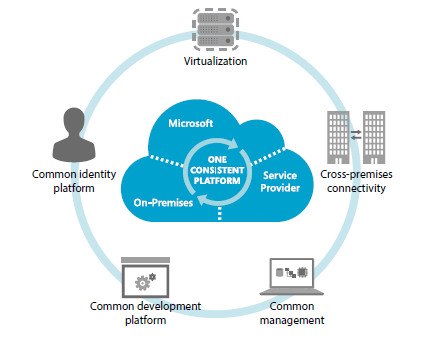Don't Get “Boxed-In”: 5 Reasons Why You Can Bet on Microsoft’s Hybrid Cloud Platform
In a blog post last week, I claimed that Microsoft Azure has a more robust hybrid cloud platform than Amazon Web Services (AWS). This principle of platform consistency across clouds is a core tenet of Microsoft’s solution, because we find that each organization has a cloud roadmap that is right for itsunique circumstances. Additionally, organizations also want to have the flexibility to be able to adapt when there are (inevitable) changes in the business environment it operates in.
However, talk is cheap - it’s easy for vendors to claim that they have a hybrid cloud (and many do). This week, I’d like to go a little deeper, and look at what makes Microsoft’s cloud solution truly hybrid. Let’s look at five capabilities of the Microsoft Cloud platform that allow you to bridge your on-premises resources with the public cloud:
- Common virtualization platform: Because a VM (virtual machine) on Azure is the same as a VM on Windows Server, it can be efficiently moved back and forth between servers in your datacenter and Azure. No need to convert your VMs to a proprietary format, especially one that has limitations on export capabilities out of the vendor’s cloud.
- Common management tools: With Azure, you can use your existing Microsoft System Center tools to manage and orchestrate Azure and on-premises resources. In contrast, AWS does not offer tools to help you manage your datacenters, nor those in your service provider’s datacenter.
- Common identity platform: Azure Active Directory offers a common identity management platform for access control to applications. With Azure AD, you can manage a growing number of users and SaaS apps that live on other clouds from the same console. Compare this to AWS Identity and Access Management, which does not address other cloud services or on-premises applications.
- Rich cross-premises connectivity: With Azure, you have options for connectivity at multiple levels of the stack, without having to rely on third-party solutions. In other words, you can connect your databases, storage, network, even your apps, between your datacenter and Microsoft Azure. By comparison, with AWS, you often have to use third-party providers for integration solutions, introducing complexity and additional cost considerations.
- Common development platform: Thanks to deep integration between Microsoft Azure and Visual Studio, your developers can efficiently build new apps using a variety of languages, conduct scale and performance tests, and run them on Azure or in your datacenters. AWS, on the other hand, offers a set of tools that put the burden on your team to manage the development and operations processes.
You can find out how the Microsoft Cloud Platform’s hybrid capabilities by downloading this whitepaper. To learn more about other areas where we believe Azure outshines AWS, please visit our new resource page.
Varun Chhabra is a Director of Product Marketing in the Cloud and Enterprise Marketing Group at Microsoft. He has worked at a variety of product marketing roles in Microsoft over the last seven years. Outside of work, he loves spending time with his wife and two year old son, reading, and running outdoors in the Pacific Northwest.
